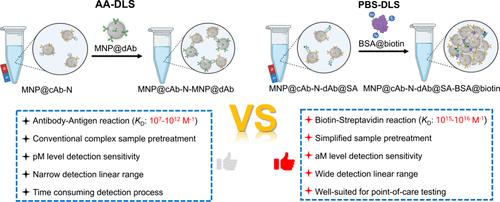PBS-DLS: A Novel Ultrasensitive Dynamic Light Scattering Immunoassay
IF 8.2
2区 材料科学
Q1 MATERIALS SCIENCE, MULTIDISCIPLINARY
引用次数: 0
Abstract
Despite significant advances in ultrasensitive detection, current methodologies are often hindered by the need for sophisticated equipment, complex signal amplification processes, and specialized operation. Here, we have developed a novel strategy by universal polyvalent biotin–streptavidin cross-linking aggregation coupled with dynamic light scattering (PBS-DLS) that effectively transduces and amplifies undetected molecular recognition events at low target concentrations, demonstrating its potential application as an ultrasensitive immunoassay. The controllability in the size and quantity of the DLS nanoprobe enables this advanced design to achieve tunable sensitivity down to attomolar levels and a broad detection range spanning six orders of magnitude. By reducing the detection time to approximately 15 min, our PBS-DLS emerges as a promising tool for point-of-care (POC) testing. Moreover, this PBS-DLS immunosensor has been validated through its rapid and ultrasensitive detection of the SARS-CoV-2 nucleocapsid (N) protein (a macromolecular model target) and malachite green (MG, a small molecule model target) in complex sample matrices, outperforming conventional immunoassays and other testing methods. The exceptional sensitivity, simplicity, and speed of this novel approach position it as a highly promising platform for the development of various bioanalytical methods and POC assays.

PBS-DLS:一种新型超灵敏动态光散射免疫分析法
尽管在超灵敏检测方面取得了重大进展,但目前的方法往往受到精密设备、复杂信号放大过程和专门操作的阻碍。在这里,我们开发了一种新的策略,通过通用多价生物素-链亲和素交联聚集结合动态光散射(PBS-DLS),在低目标浓度下有效地转导和放大未检测到的分子识别事件,证明了其作为超灵敏免疫分析的潜在应用。DLS纳米探针的尺寸和数量的可控性使这种先进的设计能够实现可调的灵敏度低至原子摩尔水平和跨越六个数量级的广泛检测范围。通过将检测时间减少到大约15分钟,我们的PBS-DLS成为一种有前途的即时检测工具。此外,该PBS-DLS免疫传感器在复杂样品基质中快速、超灵敏地检测SARS-CoV-2核衣壳蛋白(大分子模型靶点)和孔雀石绿(小分子模型靶点),优于传统的免疫测定等检测方法,已得到验证。这种新方法的特殊敏感性、简单性和速度使其成为开发各种生物分析方法和POC测定的极有前途的平台。
本文章由计算机程序翻译,如有差异,请以英文原文为准。
求助全文
约1分钟内获得全文
求助全文
来源期刊

ACS Applied Materials & Interfaces
工程技术-材料科学:综合
CiteScore
16.00
自引率
6.30%
发文量
4978
审稿时长
1.8 months
期刊介绍:
ACS Applied Materials & Interfaces is a leading interdisciplinary journal that brings together chemists, engineers, physicists, and biologists to explore the development and utilization of newly-discovered materials and interfacial processes for specific applications. Our journal has experienced remarkable growth since its establishment in 2009, both in terms of the number of articles published and the impact of the research showcased. We are proud to foster a truly global community, with the majority of published articles originating from outside the United States, reflecting the rapid growth of applied research worldwide.
 求助内容:
求助内容: 应助结果提醒方式:
应助结果提醒方式:


